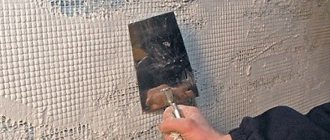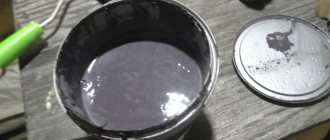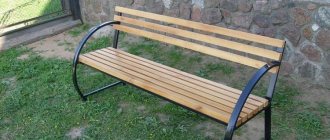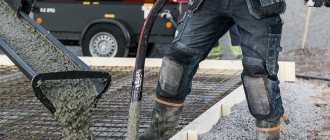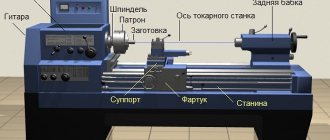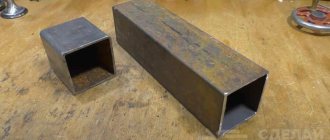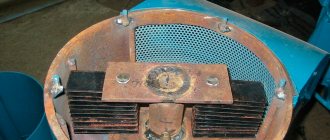Bronze paint is used to give painted surfaces a characteristic texture and metallic sheen. It can be applied to a wide variety of surfaces, including plaster, wood, metal, glass, etc.
Next we will look at what this paint is and how it is used.
Applying bronze paint
Description and purpose
Bronze paint is used for decorative purposes. Using paint and varnish, which gives the painted surface a bronze appearance, you can paint products made of wood (frames, crafts), metal (gates), plaster (figurines), and concrete.
The main ingredient of any bronze paint is bronze powder. The powder is obtained from copper or copper alloy. The crushed metal gives the paintwork a brownish-green golden color. In addition to metal powder, the paint may contain resins, varnishes, and polymers. You can make your own dye based on powder and drying oil.
Types of bronze coatings:
- acrylic (for wood, interior work);
- alkyd (for metal);
- oil (for painting);
- adhesive (for decorative finishing);
- with a hammer effect (to give roughness);
- organosilicon (for metal, concrete);
- in the form of an aerosol (for spraying on a relief surface);
- anti-corrosion (for metal fences);
- heat-resistant (for heated surfaces).
The main feature of bronze paint is its versatility. Paintwork materials can be simultaneously used for painting and protecting the surface from the adverse effects of external factors (moisture, mechanical abrasion, damage). Objects and objects painted in bronze retain their original appearance for several years. The durability of the paint depends on its composition. The most durable coatings are those based on organosilicon and alkyd resins.
Bronze paints for metal
Bronze-colored metal paint is the leader in sales among compositions for interior work.
This color is incredibly popular not only in classic, but also in modern interiors. Bronze is similar in color to copper, but you can tell them apart. Copper has a reddish tint, while bronze has a greenish tint due to the presence of tin in the alloy. One of the fashion trends has become decorative antique processing (patination). Bronze metal paints are used in painting forged products, including interior stairs and railings, window grilles and furniture, lamps and interior items. Together with zinc primers they can be used for exterior painting, as well as 3-in-1 combination compositions.
Types of bronze paint for metal
- Hammer
. A beautiful decorative effect that creates embossed surfaces. Irregularities and potholes resemble blows with a hammer on metal. They hide base defects and give products a pleasant texture to the touch. Hammer coatings can be seen on steel doors, safes, radiators and fences. Bronze metal paint Zinkor-Top Hammer 3 in 1 is intended for external treatment. It not only creates a finishing coating, but also acts as a primer with rust inhibitors (converters). - Semi-gloss
. Initially, bronze has a glossy shine, but it darkens quite quickly due to interaction with moisture and air. Products with a semi-matte finish look more natural, so Zinkor-Top Semi-Gloss paint is often used for painting. Gives the metal a noble appearance and expands the possibilities of its use in the interior. Another advantage is that it is a ready-made paint for metal with a combined composition of 3 in 1. It forms a primer layer, transforms rust and creates a finishing coating. - Patina
. For bronze and copper products, aging technology (patination) is often used. Over time, these metals develop a greenish coating, which is recreated by bronze paints with a patina effect. To obtain a vintage finish, Zinkor-Top Patina paint is applied to the cleaned metal. For anti-corrosion treatment, you must first apply zinc primer. And fireplace grates and barbecues that come into contact with fire must be treated with heat-resistant enamel modifications.
Bronze paints for artistic forging
Forging paints allow you to independently perform cold galvanizing and process forged products. Zinkor-Top paints are economical, quick-drying compositions. They can be applied with improvised tools (paint, roller, spray gun). Thanks to various effects, they are suitable for vintage and trendy products. They create protective and decorative coatings with anti-vandal properties. They will not need to be constantly updated. Together with the primer, one coat of paint provides anti-corrosion protection for 10 years. To save processing time, 3-in-1 combination paints and primers are offered.
Do you need advice and help in choosing the right composition?
Call us at: +7, 8 (800) 555-34-18
You can leave a request in writing by e-mail:
[email protected]
We work for
Call right now, we guarantee the quality of our products and affordable prices!
Features and characteristics of the composition
Bronze paint comes in different types. The characteristics of paints and varnishes depend on the composition. Using a dye that gives the painted surface a bronze appearance, you can paint any item or object. Such paint necessarily contains the finest powder obtained from copper or a copper alloy. The use of a metal base gives paintwork a number of features.
Advantages and disadvantages
most paints and varnishes have a one-component form and are completely ready for use;
simultaneously colors and protects the surface from the negative effects of external factors;
gives the painted product or object a sophisticated and presentable look;
Resin-based coatings have anti-corrosion properties;
heat-resistant bronze enamels can be used to paint heated objects;
applied to the base using a brush, roller, or spray gun.
most formulations have a high price;
Resin- and solvent-based coatings have a toxic composition.
What color is bronze, why is it called that?
Bronze belongs to the yellow palette, there are different shades from greenish to dark brown. The tone has a metallic tint when the surface is exposed to ultraviolet radiation. Refers to warm and rich shades, it all depends on the combination where the option is used.
If you place bronze near darker shades, it will appear light and complement the overall look. Used with pastel shades helps to accentuate the bronze color, giving an elegant appeal. Considering what tone needs to be added to combine with this type, professionals suggest choosing a dark option or light colors.
You can skillfully combine it with almost all shades; it is important to choose the appropriate tone for a particular case. The use of bronze is popular not only for interior design, but also for clothing and hair dye.
Cars can also be supplemented with accessories, or even be completely bronze, so the import of a bronze Range Rover to our country was unique; some motorists like to install wheels in this color.
The tone has a metallic tint when the surface is exposed to ultraviolet radiation.
How to make it yourself
Manufacturers of paint and varnish products produce several types of bronze paints. Such paints and varnishes are completely ready for use and are applied to the base manually using a brush, roller or spray gun. If you wish, you can make your own bronze dye.
See also
How to paint a guitar with your own hands at home and what varnishes to choose
First you need to buy the components from which the composition is made. You can get paint that gives a product or object a bronze look from bronze powder (sold in small bags in hardware stores) and drying oil. This composition is usually used to paint wooden objects and plastered walls.
When making dye, certain rules and proportions are followed. For ¼ powder take ¾ drying oil. The components are combined and mixed well. The main thing is to pour the drying oil into the powder, and not vice versa. Alkyd wood varnish can be used as a binding component in the manufacture of the coloring substance. Usually 50 grams of bronze powder are mixed with 1 liter of drying oil or resin.
Some people even make their own heat-resistant bronze paint. This composition is used to paint stoves, fireplaces, and radiators. To make the dye, organosilicon varnish KO-185 and bronze powder are used. When mixing, the following proportions are observed: 2 parts powder and 5 parts resin. If the composition turns out to be very thick, it is diluted with a solvent.
Using bronze powder and polyurethane varnish you can obtain paint with anti-corrosion properties. This composition is used to paint a metal fence and elements of the front door. The powder is mixed with varnish in a ratio of 1:4. The thick mixture is diluted with a solvent.
Expert opinion
Zakharova Irina Yurievna
Cleaning professional with 15 years of experience. Our best expert.
Ask a Question
It is not recommended to add bronze powder to finished enamels. When introducing powder into the composition, the properties of paintwork materials can be changed for the worse. Bronze powder mixed with ready-made enamels will lose a number of useful characteristics.
Spraying method
Painting by spraying, which uses bronze powder, is used in cases where objects with simple relief are subject to decoration. This coloring is performed in the following sequence.
- First, the surface must be prepared to ensure reliable adhesion of the paint layer to it.
- Dry powder paint is poured in a heap onto gauze laid in several layers. Gauze with sprinkled powder must be tied into a knot.
- A binder, which can be varnish or glue, is applied to the product to be painted. When applying the binder composition with a sponge or fabric swab, you must ensure that no fabric fibers or other foreign inclusions remain in its layer, which will worsen the decorative characteristics of the finished coating.
- While the binder composition has not hardened and is in a fluid state, shake a bundle of metal powder over it. Gauze, folded in several layers, acts as a sieve, through the cells of which only the smallest particles of paint powder spill out. When small particles of bronze powder fall on a layer of varnish or glue that has not yet hardened, they firmly adhere to it, forming a very beautiful and durable coating.
The great advantage of this painting method is that small particles of bronze are not coated with varnish or glue, which means they retain their bright metallic luster.
Criterias of choice
Most people prefer to buy ready-made paints and varnishes. Such bronze compositions are completely ready for use and are distinguished by a number of unique properties. The main thing is to choose the right paint. The type of paintwork must match the surface to be painted. The characteristics of any composition are written on the label.
See also
What can you draw with gouache, top 7 techniques and master class for beginners
List of existing bronze paintwork materials:
- acrylic dispersion (for wood, ceramics, plastic, painting objects, painting walls);
- bronze powder and drying oil (for wooden products, plastered walls);
- acrylic in cans (for painting relief products);
- organosilicon (for anti-corrosion painting of metal, for concrete and brick bases);
- heat-resistant (for fireplaces, stoves, radiators);
- alkyd (for wood, metal, plastered surfaces);
- oil (for artistic painting).
Rules and features of application
Bronze paint is no different from any other paint and varnish material. This is a composition that is applied to the prepared surface. The same items are used for application as for conventional dyes. Surface painting is done manually.
The main stages of using bronze paints and varnishes:
- prepare (clean, degrease, prime) the base for painting;
- wait until the surface dries;
- mix the composition;
- if necessary, add solvent or water;
- apply to the surface using a brush, roller, paint sprayer;
- you need to paint the object from top to bottom with vertical or horizontal strokes;
- wait for the first layer to dry and apply the second;
- wait for the composition to dry completely.
The finished bronze paint must be mixed well before use. If the composition is too thick, it can be diluted with water or solvent. The type of thinner is indicated in the instructions, which are usually written on the label. Aqueous acrylic dispersions are usually diluted with water. To dilute varnish-based paints and varnishes, solvents (white spirit) are used.
It is recommended to prepare the surface before painting. Do not paint wet or dirty products and objects. First, the surface must be cleaned of dirt and dust. If the product has been previously painted, it is advisable to remove the remnants of the old cracked coating. If the base is too smooth, it is recommended to sand it with sandpaper. It is advisable to degrease the surface to be painted.
Before applying paint, the base can be treated with primer. The type of primer is selected depending on the surface. There is a primer for wood, concrete, plaster, metal, universal. Priming strengthens the surface, improves paint adhesion, and reduces paint consumption. It is possible to paint products not treated with primer, but it is not advisable.
See also
Composition and technical characteristics of protective enamel EP-140, consumption per 1 m2
The paint is applied to a dry, clean, prepared base. To apply the composition, use brushes, rollers or a paint sprayer. The thickness of the mixture depends on the painting method. For a paint sprayer, a liquid composition is made (the paint is diluted with a solvent or water). When using a brush, the mixture may be thick, similar to sour cream.
Usually bronze paint is applied in 1-3 layers (no more). The coating should not be made too thick, otherwise it will soon crack. After applying one layer of paint to the surface, wait several hours for it to dry. The drying interval is indicated in the instructions. You cannot apply a second coat over a wet first coat. During the drying process, care must be taken to ensure that no water or dust gets on the surface. The painted product dries completely within 1-3 days.
If you use homemade paint for painting, it is recommended to prepare the mixture before applying it to the base. First you need to mix the powder with varnish, and then dilute the composition with a solvent. For painting use brushes, rollers, and a spray gun.
Coloring methods
The method of work is chosen based on the subject itself. There are two types of work: painting smooth and embossed objects. The most commonly used tool for applying paint is a spray gun. To make the coating more flexible, paint is applied in a thin layer, for this it is rubbed over the entire product with a brush or sponge; when using nitro varnish, I use quick movements, because it dries quickly. When working with metal, in order to prevent rust from appearing on it in the future, it is first primed. It is better to choose a soft natural brush.
To make the coating more flexible, paint is applied in a thin layer.
Painting surfaces with complex relief
Relief products require special attention and skill. Indeed, thanks to their bending shapes, the saturation of the paint on them should be adjusted in order to obtain the necessary shadows. To do the job beautifully, it is advisable to have artistic skills. The following recommendations will also help:
- Brown paint from an oil base is added to the oil varnish. The varnish itself, after adding paint, should not lose transparency, but should become slightly golden;
- The surface is completely covered with this mixture;
- The working surface is tilted so that when spraying the powder in large quantities falls on the protruding parts.
This method will help to get a good difference between the protruding parts and the recessed parts.
To do the job beautifully, it is advisable to have artistic skills.
Smooth surfaces are much easier to paint. Painting is carried out as a standard either with a brush, or the products are covered with a can of paint, if this type of paint was purchased. The distance between the product and the spray can should be approximately 20-30 centimeters, it is better to first practice and spray paint on an unnecessary surface to understand the principle of operation and paint the product beautifully and evenly.
The distance between the product and the can should be approximately 20-30 centimeters.
Spraying method
This method is suitable for painting products with simple relief. The work includes a number of actions:
- First, prepare the surface to be painted to obtain good adhesion to the paint solution. It is cleaned of all contaminants; if areas with rust are removed from this metal product, the wood must be sanded.
- Dry bronze powder is poured onto gauze, which is first bent several times. The gauze is tied in a knot.
- The binding component that was chosen for painting work should be painted onto the desired object; it can be applied with a sponge or a lint-free cloth, a piece of leather will do. Make sure that the substance is not exposed to any elements that could give the product an uneven coating.
- Before the binding component hardens on the object, powder is sprinkled on it. The gauze serves as a strainer, allowing only the smallest particles of powder to pass through. By combining with the binding component, the powder is well fixed, so the coating will be durable and beautiful.
The advantage of this method is that the particles of bronze powder are not covered with binding agents, and accordingly the product will be covered with a natural bronze sheen.
This method is suitable for painting products with simple relief.
Coating surfaces with a bronze color can decorate and make them unique, also achieving an antique or antique effect. This way you can create vintage items at home that are now in fashion. This antiquity effect may be appropriate if the interior of the apartment implies the presence of such decor. Working with paint is not difficult, but requires compliance with safety rules due to its explosion hazard. Convenient aerosol paints are available for sale; they are even easier to apply. With this method you can give objects a second life.
